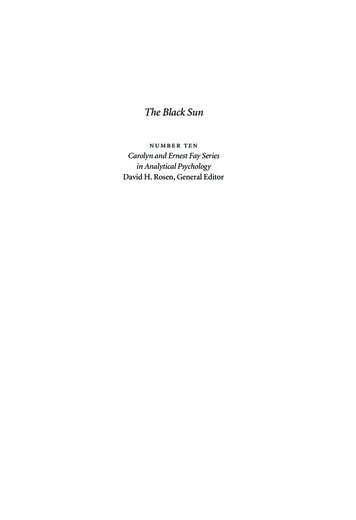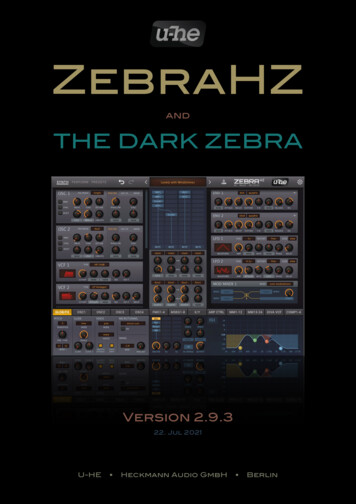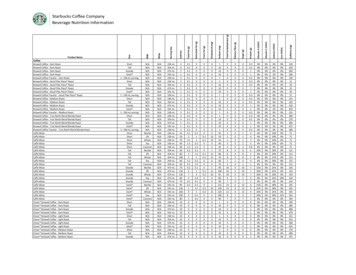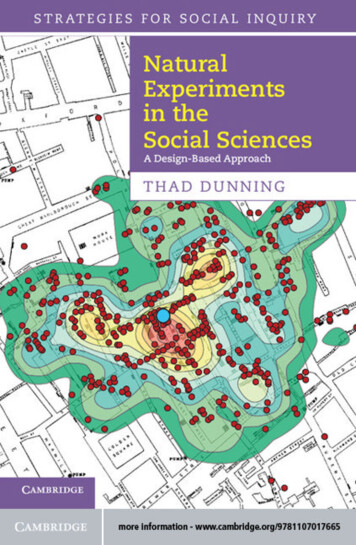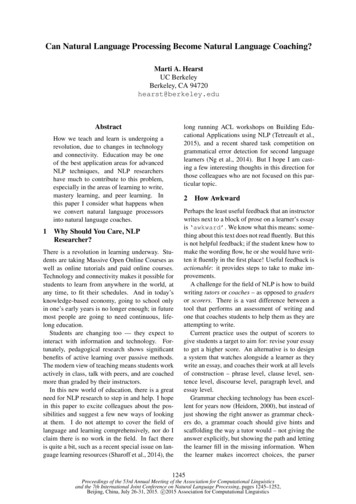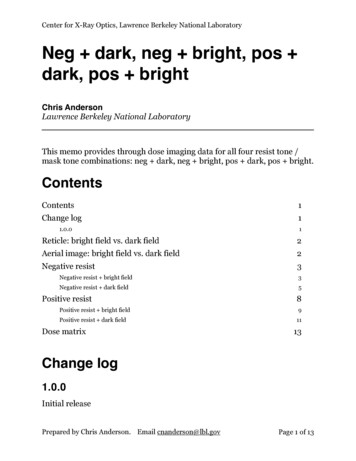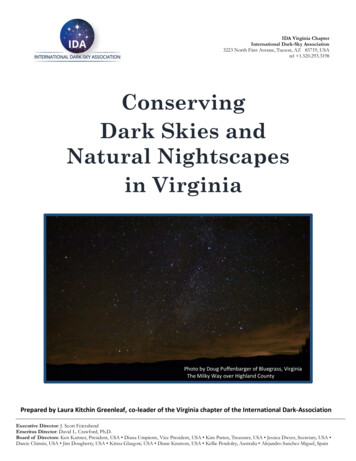
Transcription
IDA Virginia ChapterInternational Dark-Sky Association3223 North First Avenue, Tucson, AZ 85719, USAtel 1.520.293.3198ConservingDark Skies andNatural Nightscapesin VirginiaPhoto by Doug Puffenbarger of Bluegrass, VirginiaThe Milky Way over Highland CountyPrepared by Laura Kitchin Greenleaf, co-leader of the Virginia chapter of the International Dark-AssociationExecutive Director: J. Scott FeierabendEmeritus Director: David L. Crawford, Ph.D.Board of Directors: Ken Kattner, President, USA Diana Umpierre, Vice President, USA Kim Patten, Treasurer, USA Jessica Dwyer, Secretary, USA Darcie Chinnis, USA Jim Dougherty, USA Krissa Glasgow, USA Diane Knutson, USA Kellie Pendoley, Australia Alejandro Sanchez Miguel, Spain
NATURAL NIGHTSCAPES AND DARK SKIES“Our fantastic civilization has fallen out of touch with many aspects of nature and with nonemore completely than with night . . . With lights and ever more lights, we drive the holiness andbeauty of night back to the forests and the sea.”Henry Beston, The Outermost House, 1928Importance of dark nights and unpolluted night skiesWhen paging through the cabin journals in many of our state parks, it is not unusual to comeacross visitors’ delighted, even ecstatic, references to a rare or first ever encounter with a dark,star-filled night sky. Until recently, coming face to face with the universe under an unpollutedsky has been part of the shared human experience, but the implacable spread andintensification of light pollution threatens starry skies with extinction.The National Park Service defines light pollution as “the introduction of artificial light, either directlyor indirectly, into the natural environment.” Commonly recognized forms of light pollution are skyglow, glare, light trespass, and light clutter.Within a matter of decades we have vanquished the stars, dousing them in a polluted sky thatreflects our overuse of artificial light. In most of the developed world residents never fullyengage their dark-adapted night vision and most cannot see the Milky Way. We havemistakenly equated the view from space of our brightly lit planet as a sign of human progressinstead of recognizing it as evidence of poorly designed outdoor ages/fig1.htm
History of night sky conservation“And when you switch on the Night,” said Dark,“Why, you switch on the crickets!And you switch on the frogs!And you switch on the stars!”Ray Bradbury, Switch on the Night“An unpolluted night sky that allows the enjoyment and contemplation of the firmament shouldbe considered an inalienable right equivalent to all other socio-cultural and environmental rights.Hence the progressive degradation of the night sky must be regarded as a fundamental loss.”2007 Declaration in Defense of the Night Sky and the Right to Starlight; UNESCO, UNWTO, IAU,etc.In 1988 the nonprofit International Dark-Sky Association (IDA) was formed to advance thecause of protecting night skies, motivated primarily by the need to protect the integrity ofastronomical observatories. Since then the “dark skies movement” has expanded to encompassissues of environmental degradation, human health and safety, energy use and climate change,and community aesthetics. IDA now has more than sixty volunteer-staffed chapters worldwideincluding twenty representing five continents.The problem of light pollution and the cause of night sky conservation increasingly haveentered the popular culture with the 2011 release of the award-winning documentary The CityDark and the 2013 publishing of Paul Bogard’s 2003 book, The End of Night, Searching forNatural Darkness in an Age of Artificial Light along with extensive coverage in generalist online,print, radio, and television media. Around the world governments from the national tomunicipal levels are enacting legislation and standards to curb the increase in light pollution—sometimes motivated by greenhouse gas reduction and energy savings goals— at a time whentechnological advances in solid-state lighting are posing both new threats and new solutions.Night Sky Conservation in VirginiaThe International Dark Sky Places program is the centerpiece of night sky conservation efforts.The award-winning program features five designations requiring a rigorous application processthat must demonstrate dedicated community support for night sky protection. As of November2017, IDA recognizes worldwide 16 Dark Sky Communities (11 in the U.S.), 53 parks (37 U.S.), 11reserves (none in the U.S.), three sanctuaries (one U.S.), and four Developments of Distinction(all in the U.S.).
In June 2015 Staunton River State Park in Scottsburg became the first IDA-certified Dark SkyPark in Virginia. This initiative began as a partnership between the Chapel Hill Astronomicaland Observational Society (CHAOS) and park management. Adam Layman, park manager,became a champion for IDA Dark Sky Park certification and forged an effective collaboration ofthe park, local officials, and CHAOS to achieve and maintain the certification. Layman nowserves on the County of Halifax Tourism Department Board of Directors, reflecting theprominence of the Park’s International Dark Sky Place status as a community asset. Number ofattendees at premier Star Parties have exceeded 200 visitors and in 2017 AstroCamp, a STEMbased summer camp for youth, purchased a nearby property because of its proximity to an IDAcertified Dark Sky Park.James River State Park in Gladstone became the second state park to apply to become an IDAcertified Dark Sky Park in 2018. A decision on the Park’s application is pending.Regional nonprofit Valley Conservation Council sponsored a well-received “Dark Sky Summit” inthe Allegheny Highlands in October 2015. Participation in the summit confirmed strong supportfor night sky conservation and “astro tourism” in the western part of the commonwealth.Other locally based efforts to conserve and promote night skies as a community asset includeadvocacy and outreach by the Rappahannock League for Environmental Protection (RLEP)based in Sperryville. RLEP has worked with the Rappahannock Electric Co-op, in consultationwith the Fairfax-based Smart Outdoor Lighting Alliance, to convert their standard pole lightingto fixtures that meet IDA’s Dark Sky Friendly lighting standards. They are also exploring thepossibility of pursuing Dark Sky Park certification for a local park. RLEP’s exemplary outreach,which includes supporting the local public school system’s interest in converting to approvedDark Sky Friendly lighting, sets a standard for effective community engagement.Just over the mountains from Rappahannock County on the eastern slopes of the Blue Ridge inFauquier County, Sky Meadows State Park staff and volunteers are developing their applicationfor their Dark Sky Park certification.Strategies for local governments1) Encourage parks and other natural areas to incorporate night-time programming, starwatches, awareness resources, and citizen science projects2) Identify community partners such as conservation nonprofits, astronomy clubs, localmembers of IDA, and science educators to form a working group to assess night skyopportunities and needs
3) Engage with local tourism staff and board to explore potential for “astrotourism”4) Reevaluate and improve existing outdoor lighting ordinance or initiate the developmentof an outdoor lighting ordinance. Address deficiencies in enforcement. Consult withVirginia IDA and the Smart Outdoor Lighting Alliance.Every October the Bull Run MountainConservancy in Broad Run hosts twoweekends of their popular HalloweenSafari. The forest comes to life on a guidednight hike where costumed charactersemerge along the way and perform naturalhistory skits that introduce parents andchildren to animals and plants native to theBull Run Mountains, highlighting thenocturnal behavior and life cycleBull Run Mountain Conservancy, Halloween Safari 2015RecommendationsIn order to regard natural nightscapes and dark skies as the natural resource they are andensure that the wonder of a starry sky is within reach for all Virginians, communities,nonprofits, and agencies should foster appreciation for our nocturnal environment through thefollowing: Development of a state parks Nightscapes program modeled on the National ParkService program.Pursuit of Certified Dark Sky Park designations (state or local) in regions prioritizedbased on quality of night skies or accessibility and Dark Sky Community designationsparticularly in more developed or populous areas.Increase in nighttime interpretative programming at state and local parks, naturecenters, and preserves. Integrate “ecology of the night” and light pollution’s impact onhabitat and wildlife into existing educational programming. Create a network or forumfor organizations to share ideas and resources.Encouragement of citizen science involvement and contribution to sky quality datathrough Globe at Night (https://www.globeatnight.org/).
RESOURCESThe International Dark –Sky Association (IDA): http://darksky.org/Virginia chapter of IDA: http://www.darkvirginiasky.org/ (Contact: lauragreenleaf@verizon.net)IDA Dark Sky Place program, guidelines for Dark Sky k-pdfmanager/IDSP Guidelines Oct2015 23.pdfStaunton River State Park, IDA Dark Sky Places river/Smart Outdoor Lighting Alliance (based in Fairfax): http://volt.org/National Park Service, Night Skies Division: orld Atlas of Artificial Night Sky pages/fig1.htmRECOMMENDED READINGBogard, Paul. (2013). The End of Night: Searching for Natural Darkness in an Age of ArtificialLight.International Dark-Sky Association. (2012) Fighting Light Pollution: Smart Lighting Solutions forIndividuals and Communities.Longcore, Travis and Rich, Catherine. (2006) Ecological Consequences of Artificial Night Lighting.
4) Reevaluate and improve existing outdoor lighting ordinance or initiate the development of an outdoor lighting ordinance. Address deficiencies in enforcement. Consult with Virginia IDA and the Smart Outdoor Lighting Alliance. Bull Run Mo
